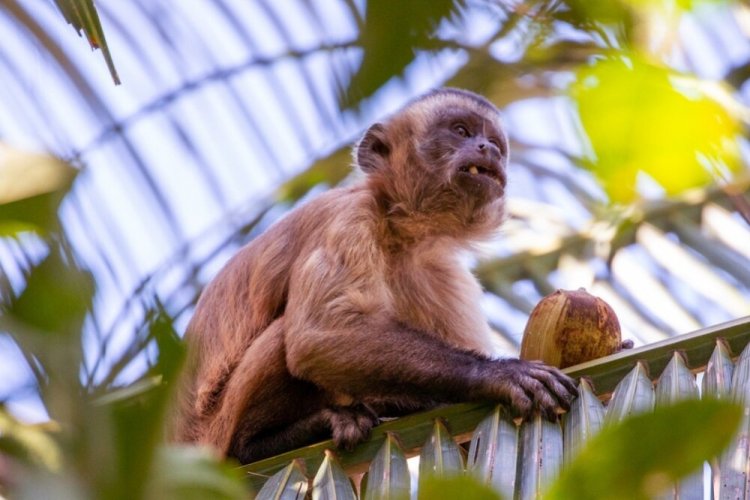Research suggests cultural heritage may influence capuchin monkeys' tool choices

Washington, US: Capuchin monkeys (Sapajus spp.) are among only a few primates that use tools in day-to-day activities. In the Cerrado and Caatinga, they use stones as hammers and anvils to crack open cashew nuts, seed pods of Hymenaea courbaril (West Indian locust; jatoba in Brazil) and other hard foods.
In an article published in Scientific Reports, Brazilian researchers show that food hardness and tool size do not always correlate as closely as has been thought.
In their study, the researchers observed three populations of bearded capuchin monkeys (Sapajus libidinosus), measuring food hardness, tool size and weight, and local availability of stones. They concluded that culture, defined as information passed on from one generation to the next by social learning, can also influence behavior in this regard.
"In one of the populations we analyzed, even when they have stones that are suitable for use on a particular food resource, they may use disproportionately heavy tools, possibly evidencing a cultural trait of that group," said Tiago Falotico, a researcher at the University of Sao Paulo's School of Arts, Sciences and Humanities (EACH-USP) supported by FAPESP.
The population to which he referred lives in Chapada dos Veadeiros National Park in Goias, a state in Brazil's Center-West region. In the study, this population was compared with capuchins living in Serra das Confusoes National Park, in Piaui, a state in the Northeast region, and another population that lives in Serra da Capivara National Park, about 100 km away in the same state.
The tools are pieces of quartzite and sandstone found in places referred to as processing sites. The animals frequent these sites solely to look for these stones for use as hammers and anvils. One stone is used to pound a nut or seed resting on another stone used as an anvil.
"In Serra das Confusoes, they use smaller tools to open smaller and softer fruit but use large, heavy hammers to crack coconut shells, which are very hard. In Chapada dos Veadeiros, where there are stones of varying sizes to choose from, they use the heaviest ones even for fragile foods," Falotico said.
Not by chance, it was in this latter park that the researchers recorded the heaviest stone lifted by capuchins. An adult male weighs 3.5 kg on average, and they filmed an individual lifting a hammer stone that was later found to weigh 4.65 kg. "They're champion weightlifters," he chuckled.
Measurements
The findings were the result of a great deal of hard work. The researchers documented the kinds of food most frequently found in the processing sites, such as babassu (Attalea speciosa), West Indian locust, cashew, and wild cassava (Manihot spp). They also documented the stones available, as well as the sizes and weights of the tools they found, measured the hardness of each type of food using a special device, and observed and filmed tool usage in each study area.
"We expected to find a very close correlation between the type of food and the size and weight of the tool, but the population in Chapada dos Veadeiros mainly used the larger ones even though stones of all sizes are plentiful and they can choose a smaller size. They probably inherited this habit from their ancestors. It's a cultural difference compared with the other populations," Falotico said.
The cultural learning hypothesis is reinforced by the fact that studies in other areas, such as Serra de Itabaiana in Sergipe and Chapada Diamantina in Bahia (both states in the Northeast), involving Sapajus capuchins, stones and the same kinds of fruit and seed have not found processing sites or the use of stone tools for this purpose. In Serra das Confusoes, the capuchins use tools to crack open several kinds of food except cashew nuts, which are nevertheless abundant.
"Their behavior isn't due to the availability of resources but to cultural heritage," Falotico said.
The researchers are now analyzing the genomes of all three populations to see if the cultural differences can be linked to genetic differences.
The study was also supported by FAPESP via a scholarship awarded to Tatiane Valenca, a PhD candidate at EACH-USP.
Human evolution
A paper by Falotico and a team of archeologists from Germany, Spain and the United Kingdom, published in the Journal of Human Evolution, reports the results of field experiments conducted to test the potential for accidental flake production during nut cracking by capuchins using various types of rock as anvils.
Some capuchins ingest or anoint themselves with powder produced by pounding stones. They may also rub the powder on their teeth. Their reasons for doing so are unknown, but the researchers believe one aim may be to combat parasites. In the experiments, flakes were also produced by fragmentation of anvils comprising homogeneous material.
The monkeys did not use the flakes, which closely resembled the lithic tools found by archeologists at digs around the world. The researchers believe the earliest hominins obtained flakes accidentally before their deliberate production for use as tools.
"Capuchins may also use flakes as tools in future if an innovative individual starts doing so, and others learn by observing. These primates can therefore serve as a model to help us understand human evolution," Falotico said.















































